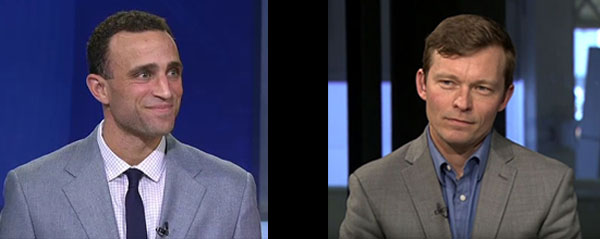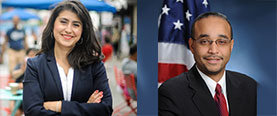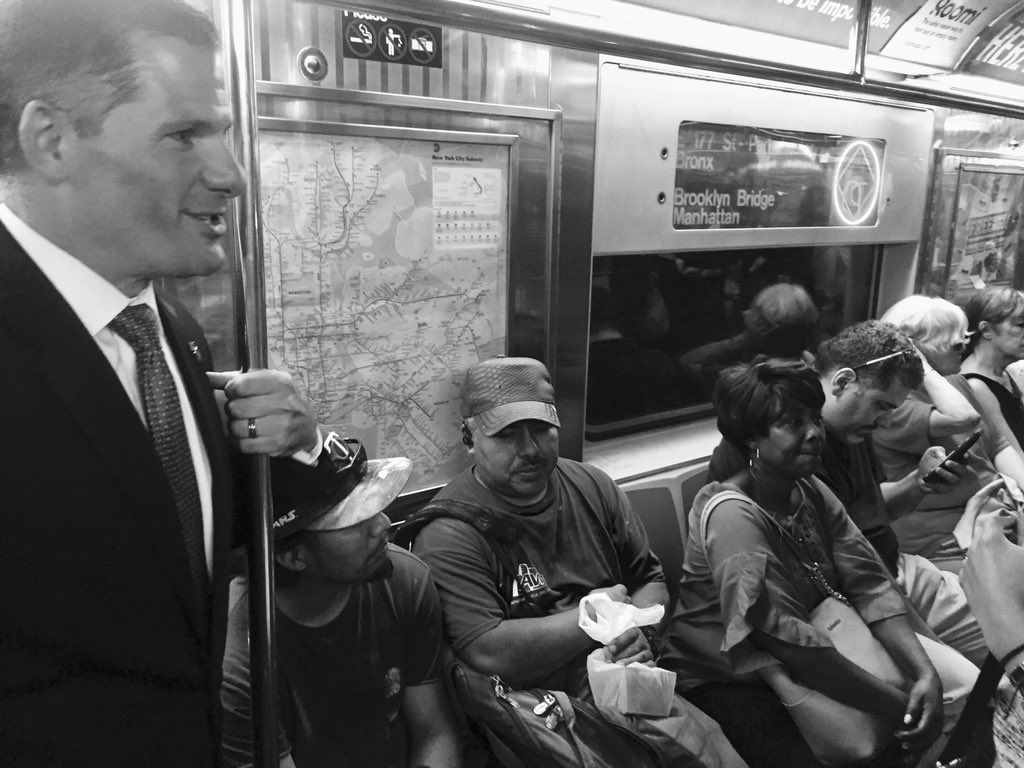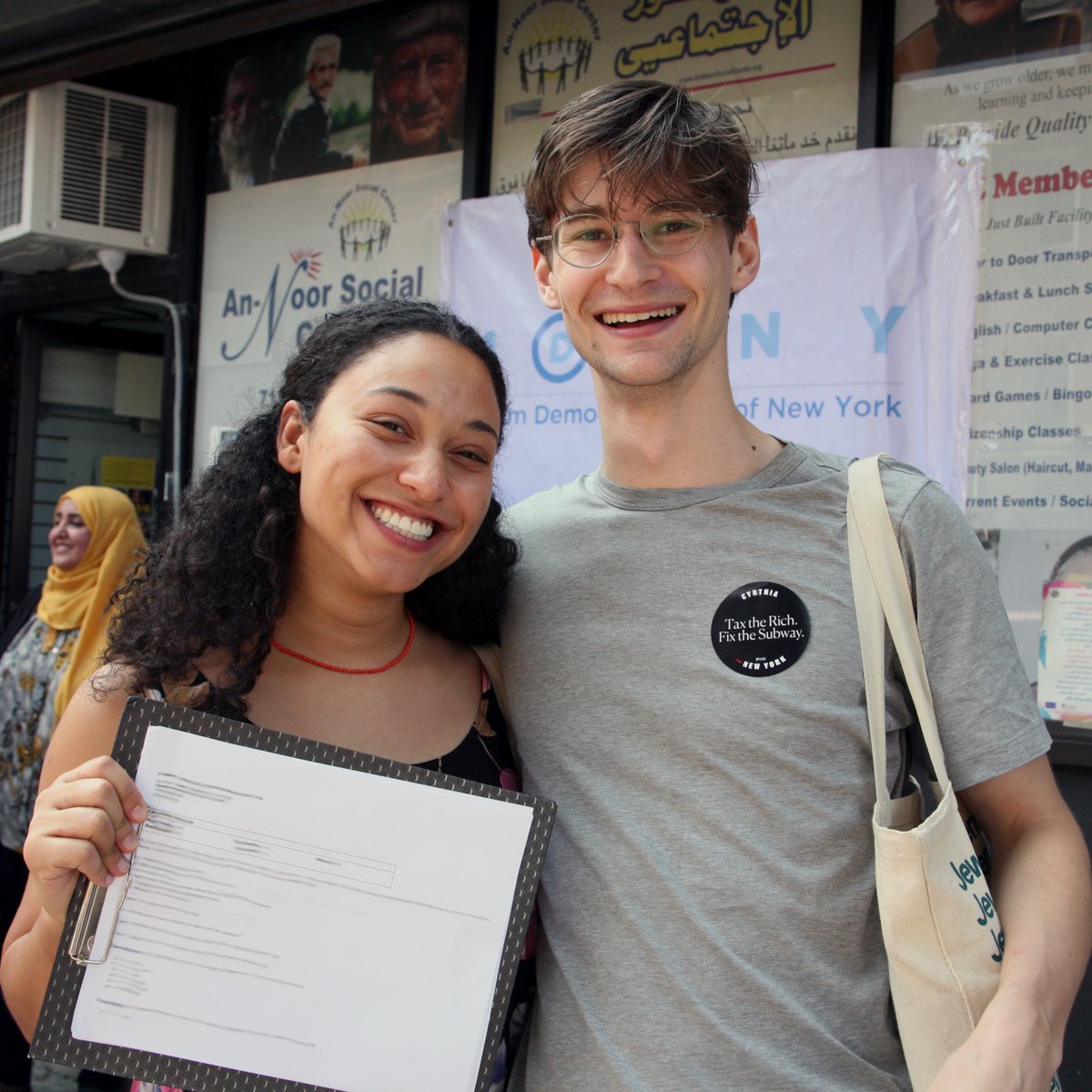Max & Murphy Podcast: Intense Queens Senate Primary Centers on Delivering for Immigrant Communities

Ben Max, left, of Gotham Gazette, and Jarrett Murphy, right, of City Limits
August 29, 2018 - Max & Murphy Podcast: An Intense Queens Senate Primary with Jessica Ramos and Senator Jose Peralta
 Jessica Ramos is challenging state Senator Jose Peralta in the Democratic primary, in a Queens district with a large immigrant population. Ramos, then Peralta joined the program to discuss their candidacies and to take questions from the hosts and listeners. At the center of the race are issues like the Dream Act, subway service, small business survival, and more. Also at play is Peralta's membership in the now-defunct Independent Democratic Conference, a breakaway group of eight senators that formed a ruling coalition with Republicans in the Senate.
Jessica Ramos is challenging state Senator Jose Peralta in the Democratic primary, in a Queens district with a large immigrant population. Ramos, then Peralta joined the program to discuss their candidacies and to take questions from the hosts and listeners. At the center of the race are issues like the Dream Act, subway service, small business survival, and more. Also at play is Peralta's membership in the now-defunct Independent Democratic Conference, a breakaway group of eight senators that formed a ruling coalition with Republicans in the Senate.
Listen to the conversation with the two candidates and let us know what you think -- we're on Twitter @TweetBenMax and @JarrettMurphy. You can listen to the show through the embedded audio below or download the episode wherever you get your podcasts, under "Max & Murphy," and listen to Max & Murphy live on Wednesdays at 5 p.m. on WBAI radio, 99.5FM or wbai.org
***
by Ben Max, Gotham Gazette
@tweetBenMax @GothamGazette
Promising Efficiency and Performance, Molinaro Releases MTA Turnaround Plan

Marc Molinaro on the subway (photo: @marcmolinaro)
Republican gubernatorial candidate Marc Molinaro said that his plan to fix the state’s ailing subway system is “not sexy,” but argued Tuesday that he will fix the MTA by doing away with what he said is Governor Andrew Cuomo’s approach, marked by uncontrolled spending, prioritizing “vanity projects” over key improvements and frequent fighting with Mayor Bill de Blasio.
For Molinaro, the chief problem facing the subway system is not lack of funding, but out-of-control costs allowed by bad management. His “Back on Track” plan, released late Monday, diagnoses the problems and puts forward solutions, emphasizing reducing costs and putting an end to what the campaign says are inefficient work rules that slow repairs.
“The MTA is falling victim to waste, fraud and abuse, and we as a state must confront the high cost of labor,” he said at a Tuesday news conference outside City Hall, citing among others the Manhattan Institute and the Regional Plan Association as sources for ideas in the 30-page plan, which also supports the recently-released “Fast Forward” plan put forth by New York City Transit Authority President Andy Byford. “If spending more money on the MTA was the answer, we'd have the best transit system in the world,” Molinaro said.
To cut costs, Molinaro is proposing lengthening work windows, which would mean longer subway service closures, with the aim of allowing for more efficient, less costly repairs.
And should Molinaro, a former New York Assembly member and currently the Dutchess county executive, be elected governor in November, the days of the state’s governor and its largest city’s mayor fighting over funding would be over, he said.
“I'm not going to argue with the mayor of New York, because the state's responsible for the MTA,” said Molinaro, adding that he would work “hand-in-hand” with de Blasio to do what it takes to fix the subway.
Asked by Gotham Gazette to break down how his plan would fill the over $30 billion in funding needs for subway system repairs, Molinaro declined to discuss specifics, instead pointing to the written plan. In it, Molinaro calls for using value capture — a mechanism that captures the increased tax revenue from rising property prices as a result of new government investment, such as a new nearby subway station.
Molinaro’s plan vaguely suggests improving the state’s economic development programs to raise revenue with “pro-growth” initiatives. Underscoring his attention to driving down costs, one of the planks under “potential revenue streams” is cutting costs of what he labels Cuomo’s “vanity projects.” At the news conference, as in his plan, Molinaro said he supports congestion pricing, though “certain boroughs need consideration” on costs of driving into the city, he said. In the plan, Molinaro says that while a version of congestion pricing, which would add a fee to cars entering the core of Manhattan, is “part of the future of the MTA,” it would need to be coupled with “major reform efforts to decrease operations and construction costs.”
Among those cost-cutting reforms are reining in health care costs, overtime pay and pensions for construction workers on MTA projects. On construction costs, Molinaro said he would welcome new technology and crack down on overstaffing on projects.
While he focused his attention during the news conference on what he views as mismanagement of MTA-related matters by Cuomo, he also embraced the fundamentals of the city’s newly passed effort to give discounted Metrocards to low-income New Yorkers. Specifically, Molinaro proposed using state funds to expand the city’s new “Fair Fares” policy to make eligible for the program individuals who earn incomes of less than 200 percent of the federal poverty line. The current policy will give half-price metrocards to the 800,000 New Yorkers below the federal poverty line — which is roughly $25,000 for a family of four.
He also proposed assessing transit desserts and expanding subway lines to underserved areas, though he did not specify which areas are most in need of service.
Molinaro on Tuesday took several shots at the governor, likening him to “some sort of deranged Wizard of Oz” due to what he said is the governor’s habit of misdirection from the core issues at hand facing the beleaguered subway system. The governor has continued to claim that the city is responsible for the MTA, even though he appoints most of the members on the MTA board — six of 14 — and its top leadership. And though the state typically contributes billions of dollars toward MTA capital plans, most of the funding that goes to the MTA comes from city residents who use its railways, subways and buses.
Abbey Collins, a spokesperson for Cuomo’s campaign, in a statement called Molinaro’s campaign a “joke,” said he lacked credibility, and conflated Molinaro’s criticism of the governor’s MTA management with attacks on its employees.
“While Trump mini-me Molinaro has been busy copying and pasting the MTA’s own plan into his policy book, it is Governor Cuomo who has appointed world-class senior leadership, secured a dedicated revenue stream, enacted the first phase of congestion pricing and charged the MTA to undertake the Fast Forward plan,” she said. “It’s clear Molinaro has exactly zero ideas of his own and instead is resorting to Trumpian assaults on the hardworking men and women who make the subways run.” The president of the state AFL-CIO, which has endorsed Cuomo for re-election, sent out a statement also criticizing Molinaro for “vilify[ing] working people and their unions.”
“He would rather blame workers for subway repair costs than recognize New York's highly trained and skilled workforce is the only thing that keeps our state moving forward,” said New York AFL-CIO President Mario Cilento of Molinaro.
***
by Sam Raskin
@samraskinz @GothamGazette
Nixon Says 'Narrow Path' to Victory Paved with Newly-Registered Progressives Polls ‘Not Capturing’

(photo: @CynthiaNixon)
As she attempts an insurgent challenge against a two-term Democratic governor with broad establishment support and deep campaign coffers, actor and activist Cynthia Nixon believes her path to victory, admittedly a “narrow” one, lies among new voters, the mostly progressive and informed New Yorkers who have registered with the Democratic Party in the last four years. The new pool of voters is massive, numbering in the hundreds of thousands, but the question is how many will come out to vote on September 13, a Thursday, and for Nixon at that.
“If you look at four years ago when Zephyr Teachout ran [in the Democratic primary for governor], she got 34 percent of the vote, despite the fact that a lot of people had never heard of her, a lot of people didn’t even know she was running, she couldn’t get on TV until the last two weeks,” Nixon said at a gubernatorial forum in Sunset Park last week, which her opponent, Governor Andrew Cuomo, declined to attend.
In certain ways, Nixon could’ve been talking about her own swing-for-the-fences run that parallels Teachout’s 2014 challenge to Cuomo. Both candidates ran with no prior government experience and from the governor’s left, pushing him to adopt more progressive positions. (Teachout was Nixon’s campaign treasurer earlier this year until she launched her own campaign for the Democratic nomination for attorney general. They have endorsed each other.)
[Read: At Brooklyn Forum, Nixon Pitches Policy, Criticizes Cuomo and Distances from De Blasio]
“The people who turn out in a Democratic primary in an off-presidential year are the most informed and the most left-leaning voters,” Nixon continued at the forum. “To be informed about Andrew Cuomo, I believe, is to want to change.”
New York is indeed a low turnout state, if not a low registration one, and in local and state elections participation is often anaemic. Only 574,350 Democratic voters cast a ballot in the 2014 primary for governor -- 192,210 for Teachout and 361,380 for Cuomo, and the rest for Randy Credico, a radio host, comedian, and perennial protest candidate -- even though, prior to the primary, there were 5,873,844 registered Democrats statewide (as of April 1, 2014). By the November general election, in fact, there were 34,585 fewer registered Democrats but Cuomo and his running mate, now-Lieutenant Governor Kathy Hochul, would go on to win by more than 2 million votes.
Two years later, the presidential primary election between former former Secretary of State Hillary Clinton and Vermont Senator Bernie Sanders shook the Democratic base and also motivated independent voters to turnout -- though many were disappointed when they showed up to the polls and ran up against New York’s closed primary system which only allows a party’s registered voters to cast a ballot or were stymied by New York’s rules around changing party registration a year in advance of a primary.
As of April 1, 2016, barely three weeks before the Democratic presidential primary, there were 5,792,497 registered Democrats across the state, lower than in previous years. By November 1, that number jumped to 6,179,734, an increase of 387,237 Democratic voters in just seven months. By April of this year, the number of registered Democrats has increased again, to 6,201,033, of which 3,401,637 are in New York City alone (NY1’s Zack Fink first crunched some of these numbers).
Between April 2016 and April 2018, 330,478 new Democrats registered in the city. Some portion of them, it is believed, changed party registration from unaffiliated in an attempt to vote in the presidential primary, but did so too late for that election.
It’s on those new Democratic voters -- more than 408,000 of them since the last gubernatorial race -- that Nixon is pinning her hopes of victory. “I think what the polls are really not capturing is that, both inspired by Bernie Sanders and horrified by Donald Trump,” hundreds of thousands of Democrats have registered to vote in New York in the last two years, Nixon said. “And I would argue that the vast majority of those are progressive voters.”
But according to an actual pollster, public polling doesn’t back Nixon’s claim, though the election will likely depend on turnout, which is tough to predict, said Siena College’s Steven Greenberg in a phone interview. In a July 31 Siena College poll, the latest in the governor’s race, Cuomo received 60 percent of the vote from likely Democratic primary voters, compared to Nixon’s 29 percent, with the rest undecided.
“I don’t believe it’s true,” that polls aren’t capturing progressive voters, Greenberg said. He noted that eight out of nine registered Democrats didn’t vote in the 2014 Democratic gubernatorial primary, though he assumed turnout may be higher this year.
“We certainly talk to new voters,” he added, insisting that Siena had polled Democratic voters who had registered as recently as June. The polling methodology also accounts for voting history to determine who will be a likely primary voter, he said. “We think we’re talking to those new voters in an appropriate way.”
Though Nixon believes the progressive groundswell in the wake of Bernie Sanders’ presidential campaign will continue to show in this year’s election, Greenberg said that notion doesn’t match up with the past. “We have seen historically that a lot of new voters register to vote in the presidential primary but don’t continue to vote after that,” he said.
And perhaps most daunting for Nixon, Greenberg pointed out, was the fact that voters who identified as liberals in Siena’s July poll overwhelmingly chose Cuomo, who beat Nixon 57-35 in that category (Nixon’s campaign has said that far left voters now identify as “progressive,” which was not an option in the poll, not liberal). Even among younger voters, below the age of 35, Cuomo won by double digits. “Andrew Cuomo has a problem with liberal and progressive leadership,” Greenberg said. “He doesn’t have a problem with rank and file liberals and progressives. They like him and they support him.”
The Cuomo campaign did not provide comment for this article.
“Nixon can make an argument, and it’s a legitimate argument, that Cuomo’s been dragged kicking and screaming to take liberal positions,” he continued. “But the voters don’t know that.”
***
by Samar Khurshid, senior reporter, Gotham Gazette
@samarkhurshid @GothamGazette




